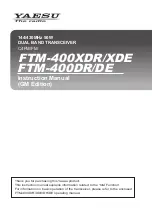
- 11 -
CALIBRATION
Unlike conventional electronic transmitters, the use of a
microprocessor and the presence of serial communications
between the transmitter and the configuration device, allows the
use of several different approaches in calibration and servicing.
Different methods can be used to calibrate the Smart transmitter:
i) using the local keys in the transmitter secondary unit.
ii) using zero/span raise/lower on transmitter electronics
links.
iii) using the Hand Held Communicator.
iv) using the Personal Computer Configuration Software
Package.
This chapter describes the first method; the others are
described next or in the relevant Instruction Manuals of
configuration tools.
In the addendum (use of hardware links on the secondary
electronics) there is an explanation of the raise/lower operation
for ZERO and SPAN. It is also possible to apply a scaling to
the reading of the transmitter.
The operation is called PV-scaling and is used to align the
"zero" of the process with the "zero" reading of the transmitter.
See the description in the Addendum for PV scaling operation.
Note: Unless otherwise specified the instrument is
factory calibrated at maximum span with the LRV set to true
zero. Instruments adjusted and tagged for a specific range
will not require recalibration. Rezeroing of the transmitter
may be required in order to compensate for zero shift
arising from the installation.
Preliminary operation
Before commencing calibration ensure that:
i) the required span, the upper and lower range value (URV &
LRV) are within the span and range limits (URL & LRL)
indicated on the nameplate (please refer to "Range and
Span" consideration on the previous page).
ii) the transmitter is properly powered and the electrical
connections correctly made.
iii) the write protect link, located on the electronics module is in
position OFF (write allowed). Access to the link is gained by
unscrewing the secondary unit housing cover at the opposite
end to the terminal cover (See Fig. 9).
iv) the Upscale/Downscale link is positioned to the required
function: ON for Downscale OFF for Upscale (see Fig. 9).
v) make the electrical connections, as indicated in Fig. 10.
Connect a precision milliammeter as shown and remove the
short circuit link.
Precision
Milliameter
Power Supply
10.5 to 42 V. d.c.
Short circuit link
Fig. 10 - Calibration electrical connections
Set up an appropriate test rig in accordance with the required
calibration. Figure 11 shows a complete test rig that can be
selectively used to suit the calibration.
M1
H
L
A
M2
Pressure Generator or
Dead Weight Calibrator
M1/M2 - Pressure gauge
V.G.
V.P.
B
C
V.G. - Vacuum Gauge
V.P. - Vacuum Pump
Fig. 11 - Calibration pressure connections
Note that calibration accuracy is strictly related to the accuracy
of the test equipment: the use of a dead weight tester is highly
recommended.
The local adjustment keys are located behind the Nameplate.
To gain access slacken the nameplate screw and rotate 90
°
;
proceed in the reverse mode when the calibration procedure
has been completed. Fig. 12 shows the keys: they provide two
large plastic heads that can be pushed, with spring return to
normal. The local adjustment can be removed after the calibra-
tion, to avoid improper use by inserting a screwdriver blade
below the plastic flange and pulling out.
M
TEST COMM
Fig. 12 - Top view of the local adjustment keys
Fig. 9 Location of the links on the electronics
and the integral digital display
Write/Write
Protect link
Upscale/Downscale
link
0
50
100
%
Содержание 264B
Страница 53: ... 53 ...
Страница 54: ... 54 ...












































